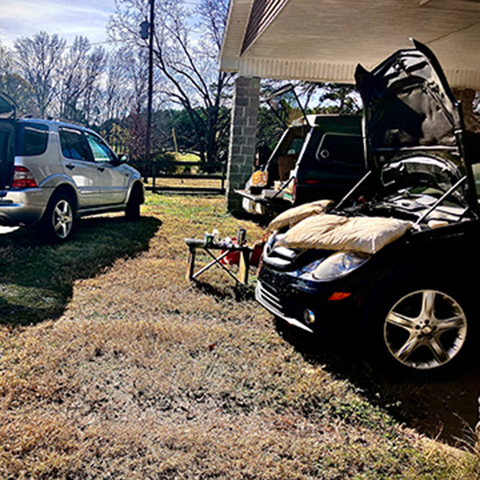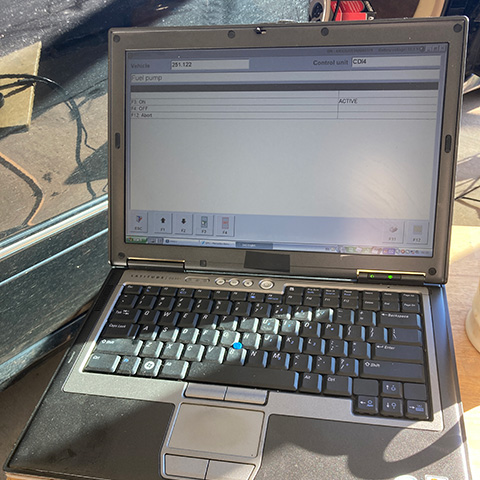Gas in the Diesel Tank
Sooner or later, most folks that have both Diesel and gasoline fueled cars will add the wrong fuel to the tank. There are A LOT of online forum posts on this issue, and I just had to face this with our 2008 R320 CDI. Fortunately, the car was not started with the 18.95 gallons of gasoline in the tank. We had it towed home then I went to work. The R320 is not a particularly easy car to work on and getting the gas out of the fuel tank posed an interesting challenge.
The first thought might be to siphon the fuel out through the fuel filler. I found that it’s very hard to get even a small diameter hose in there. I was able to get about 2 gallons out this way, but the next day when I tried to insert the tube, I couldn’t get it in. You might also think about going in through the fuel pump access under the back right seat, that is unless you read my previous article about changing the fuel pump – it’s really hard to get in there due to the access panel being essentially glued in with seam filler and the need for a special tool to remove the pump.
I decided to use the fuel pump to empty the tank. I removed the small hose from the fuel filter, hooked up a hose and led it to a fuel can. I turned on the ignition and immediately had a spray of fuel over the top of the engine – whoops, wrong hose! Probably should have been obvious, but it turns out the supply line to the filter is the large diameter hose, so I swapped the collection apparatus over to the correct hose. I was planning to use the activations feature of one of my scanners to turn on the fuel pump, but I found that neither my Foxwell NT530 nor my Icarsoft supported that function. I hooked up my clone Star system (the first time I’d really used it) and found the fuel pump activation. This allowed me to turn on the fuel pump for a short time (maybe fifteen seconds) repeatedly to pump the tank. Note that the fuel pump runs for about the same length of time when you turn on the ignition, so you don’t really need the STAR system to do this. The advantage of the STAR system was that I could set up the laptop on table by the right rear wheel where I could hear the fuel pump well, and I could easily tell when it was sucking air.
This sounds pretty straightforward but there are some subtleties. This car has saddle tanks, and the fuel pump is on the right side. It wasn’t too long before I could hear the fuel pump sucking vapor and since I was tracking how much fuel had been removed, I knew I was nowhere near having the tank empty. I jacked up the left side of the car but that didn’t help much. The STAR system was helpful but also a little confusing, as it allows you to see the raw data from the fuel level sensors; it has two, one on each side of the tank, which are processed to feed the fuel level meter on the dashboard. The confusing part is that they read the opposite of what you’d expect in that a larger number corresponds to a lower fuel level. This was not obvious, but clicking on the additional information icon reveals this idiosyncrasy. This allowed me to verify what I already knew - I still had gasoline in the left side of the tank.
I did a little internet searching and learned that the car relies on a Venturi pump to move fluid from the left side of the tank to the right side. The Venturi pump uses return line fuel to “suck” the fuel to the right side. When pumping fuel directly to a fuel can, there is no returning fuel so there is nothing to move the fuel from the left side to the right.
To resolve this, I added several gallons of Diesel fuel to the tank, then hooked the fuel lines back up to the fuel filter. I then ran the fuel
pump to recirculate fuel to the return line and help move the fuel from the left to the right side of the tank. Then I pumped this mixture out and did the sequence a second time. When I had the tank as low as I could get it, I filled it to the brim with Diesel fuel and replaced the fuel filter. I then flushed the lines out, hooked them back up and recirculated until I heard no more vapor going through the fuel pump. I had been doing dilution ratio calculations and figured that I had about 3.8% gas in the Diesel fuel by this time. I learned later of an incident where 5 gallons of gasoline had been added to an ML Bluetech’s tank resulting in about 25% gasoline concentration in the Diesel fuel; this car was subsequently run with this concentration and had no problems.
Holding my breath, I started the car. It took just slightly longer to start than normal, then was perfectly fine. A big towing bill, about 7 gallons of unusable gas/Diesel mixture and about a day of my time and the car was back operational. Whew!












